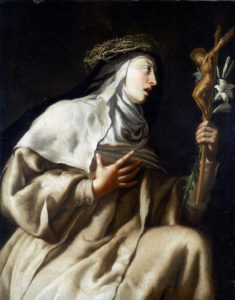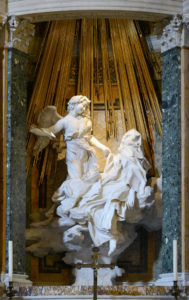Born in an era between the voyages of Columbus and the Protestant Reformation, St. Teresa of Avila seemed destined from birth to have a prominent place in history.
Teresa de Cepeda y Ahumada was born in Avila, Spain, on March 28, 1515 into a noble Spanish family. Her family is reported to have descended from “Converso” or Jews who were forced to convert to Christianity during the Inquisition.
Teresa was outgoing and adventurous as a child; one story recounts her and her brother Rodrigo going “off to find the Moors” to sacrifice themselves for Jesus; thankfully an uncle intervened and brought the children home.
Her mother died when Teresa was in her early teens, and she developed a great devotion to Mary after her mother’s death. Not knowing what to do with his high-spirited daughter, her father placed her in residence in a Carmelite convent when she was 16. At age 18, she officially entered religious life.

Teresa studied theology, including the “Spiritual Exercises” of St. Ignatius of Loyola, and St. Augustine’s “Confessions.” She regarded herself as a great sinner and felt a connection to the life of Augustine.
When she was only 24, Teresa was stricken with malaria. She was so seriously ill — unconscious for four days — that she was thought to be dead, and a grave was prepared for her. She awoke and was partially paralyzed for a time after. She never completely recovered and spent the next several years in contemplative prayer.
When she was 29, Teresa began having mystical visions. In one account, an angel appeared before her and pierced her heart with a lance. Her account of this event was the inspiration for Bernini’s sculpture, “The Ecstasy of St. Teresa.”

Although Teresa lived a quiet prayerful life in cloister, she was also very sociable and outgoing. Perhaps these two aspects of her personality made her the perfect person to lead the Carmelite Reform. She noticed that the Carmelite communities of the time had become lax in their usual practices of poverty and devotion to prayer. Teresa wished to lead the Carmelites back to a life of austerity that included poverty, physical mortification, and prayer with focus on the Divine Office. She was met with resistance; her actions, combined with her visions, led her to be mocked and treated suspiciously, even to the point of being investigated by the Inquisition. Eventually, with support of King Philip and Pope Gregory XIII, she was allowed to continue her work, founding the new branch known as the Discalced Carmelites.
Teresa founded 17 convents throughout Spain in twenty years, and with her friend St. John of the Cross, also founded two monasteries for men.
Aside from her earthly work, Teresa was also a prolific spiritual author. Her writings include Devotion of the Heart, Devotion of Peace, Devotion of Union, Devotion of Ecstasy, The Way of Perfection, The Interior Castle and her autobiography.
As in the era of her birth, her death was touched by historic significance as well. The week Teresa died, the world was switching over to the Gregorian calendar; days were eliminated from the month of October as part of the process, so Teresa died either on Oct. 4, or the next day, which was technically Oct. 15. She was originally buried at the Convent of the Annunciation in Alba de Tormes, but her incorrupt body was later moved back to Avila. Her relics can be found there, and in Rome; Lisbon; Ronda, Spain; and Loreto, France.
Teresa of Avila was canonized in 1622. In 1970, she was declared a Doctor of the Church, along with St. Catherine of Siena, the first women to receive this honor.
St. Teresa of Avila’s Feast Day is Oct. 15.
She is the patron of headache sufferers and Spain
Read her biography at Franciscan Media here: https://www.franciscanmedia.org/saint-teresa-of-avila/
There was a Spanish television movie produced about her life. Read more about it here.
There are Carmelites all over the world, including nearby Philadelphia, Pa. Learn more about them here:
A Carmelite Novena to St. Teresa can be found here.
A daily prayer by St. Teresa:
“Let nothing disturb you.
Let nothing make you afraid.
All things are passing.
God alone never changes.
Patience gains all things.
If you have God you will want for nothing.
God alone suffices.”
— St. Teresa, The bookmark of Teresa of Ávila,










